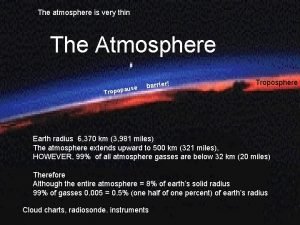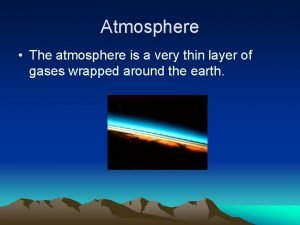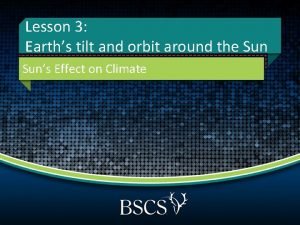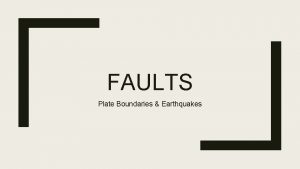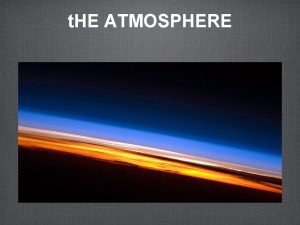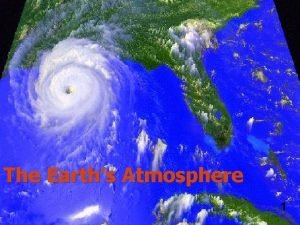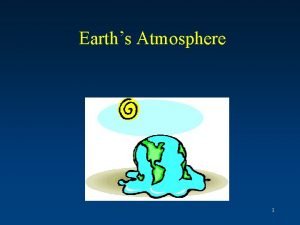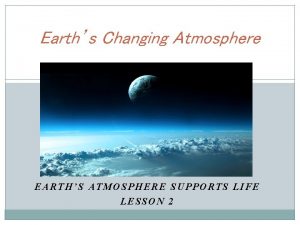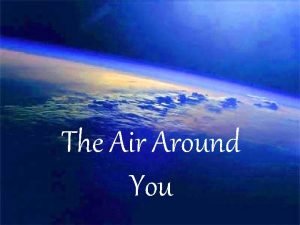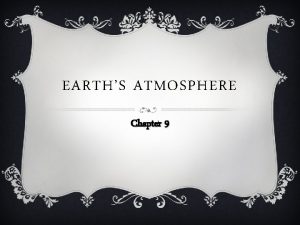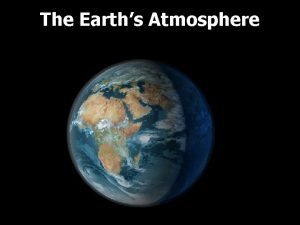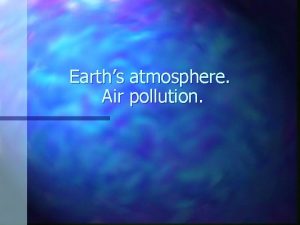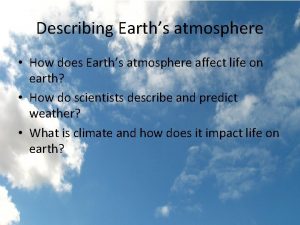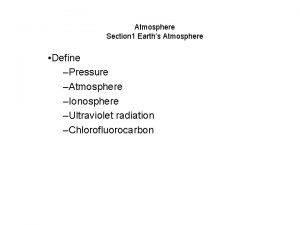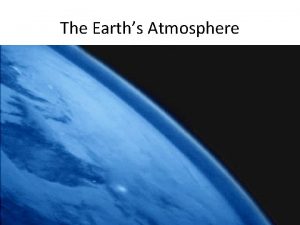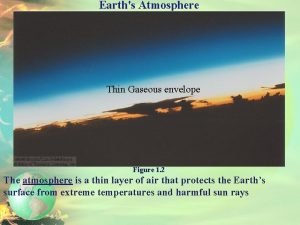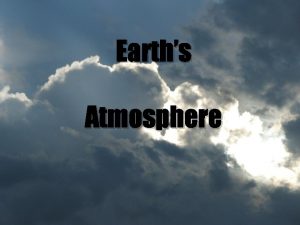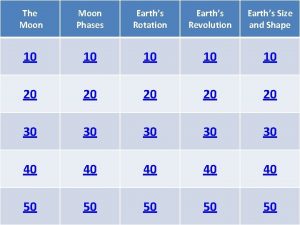Earths Atmosphere Atmosphere The atmosphere is a thin



















- Slides: 19

Earth’s Atmosphere

Atmosphere § The atmosphere is a thin layer of gases that surround the Earth. § The atmosphere protects the Earth by balancing the amount of heat absorbed from the Sun and the amount of heat that escapes back into space.

The Past Atmosphere Earth’s early atmosphere was created from volcanic gasses. It is theorized that 4 billion years ago the Earth’s atmosphere contained two deadly gases: methane and ammonia.

How did the atmosphere change? § Methane is made up carbon and hydrogen. § Ammonia is composed of nitrogen and hydrogen. § Sunlight caused chemical reactions among the methane, ammonia and water in the air. § New materials, nitrogen, hydrogen and carbon dioxide, were formed as the methane and ammonia broke down.

Ancient Atmosphere § The water vapor remained. § Hydrogen, a lightweight gas, escaped into space. § Nitrogen, carbon dioxide and water vapor were left.

Earliest Life § Eventually, certain types of microorganisms called blue-green bacteria started to appear on or near the water’s surface.

Blue-green Bacteria § These bacteria used the energy in sunlight to combine carbon dioxide from the air with water to produce food. § A byproduct of this foodmaking process was oxygen. This was the first “free oxygen”. § These were the stromatolites.

Oxygen § Sunlight then broke down the water vapor in the upper atmosphere into hydrogen and oxygen. The hydrogen again escaped. § Other oxygen was generated by stromatolites

Oxygen § Oxygen remains near the surface of the Earth. § This is the oxygen that animals breathe today. § Green plants began to grow on land take in carbon dioxide and release oxygen in the food-making process.

Ozone Layer § The oxygen in the upper atmostphere bonded, in sets of three, to form a gas known as ozone. § A layer of ozone gas formed between 35 and 60 km above the Earth’s surface. § The ozone layer reflects harmful ultraviolet radiation from space.

Today’s Atmosphere § 600 million years ago the amounts of oxygen and carbon dioxide in the atmosphere began to level off.

Composition of the Atmosphere § Nitrogen gas makes up about 78 percent of the atmosphere. § Oxygen accounts for 21 percent. • The remaining 1 percent is a combination of carbon dioxide, water vapor, argon and trace gases.

Layers of the Atmosphere § The atmosphere is divided into layers according to the major changes in its temperature. Layers with thinner particles can hold less heat.

The Troposphere § This is the layer closest to the Earth. § Weather occurs in this layer. Life occurs here. § The height of the troposphere varies from 17 km at the Equator to 8 km at the poles. § This layer contains 99% of the water vapor.

The Stratosphere § The stratosphere extends from the troposphere to an altitude of about 50 km. § In the lower stratosphere, the temperature is around – 60 degrees C. § Here very strong eastward winds called the jet streams reach speeds of 320 km per hour. The jet streams move faster in the winter than in the summer helping storms move across the United States.

The Mesosphere § In the mesosphere, 50 -90 km above the earth, the temperature begins to decrease to – 100 degrees C. § The upper region is the coldest. If water vapor is present thin clouds of ice form § The mesosphere protects the Earth from meteoroids. When they reach the mesosphere, they burn up from the friction of rubbing against the particles of gas.

Thermosphere § The thermosphere begins at a height of about 90 km. § Thermosphere means heatsphere. The temperatures reach 2000ºC because this layer absorbs the ultraviolet radiation from space and converts it into heat. § A thermometer placed in thermosphere would register nothing because the particles are so far apart that not enough of them are present to affect a thermometer.

Ionosphere § Within the mesosphere and thermosphere is a layer of electrically charged particles called the Ionosphere. It allows radio waves to travel around the earth.

The Exosphere § The upper thermosphere is called the exosphere. § The exosphere extends from 550 km above the surface for thousands of km. The air is very thin. § Artificial satellites orbit in the exosphere.
 Earths early atmosphere contained
Earths early atmosphere contained Relative ause
Relative ause A very thin layer
A very thin layer What does the earths tilt cause
What does the earths tilt cause Earths orbit seasons
Earths orbit seasons What does earths tilt do
What does earths tilt do Earths biomes
Earths biomes Pangea explanation
Pangea explanation Thickest layer of the earth
Thickest layer of the earth What is atmosphere
What is atmosphere The earth's layers foldable
The earth's layers foldable Study of earth's physical features
Study of earth's physical features Brown earths
Brown earths Earths boundaries
Earths boundaries Pnitogens
Pnitogens Earths crust
Earths crust The earth layer foldable
The earth layer foldable What is this shape
What is this shape Earths roation
Earths roation Earths honey
Earths honey

